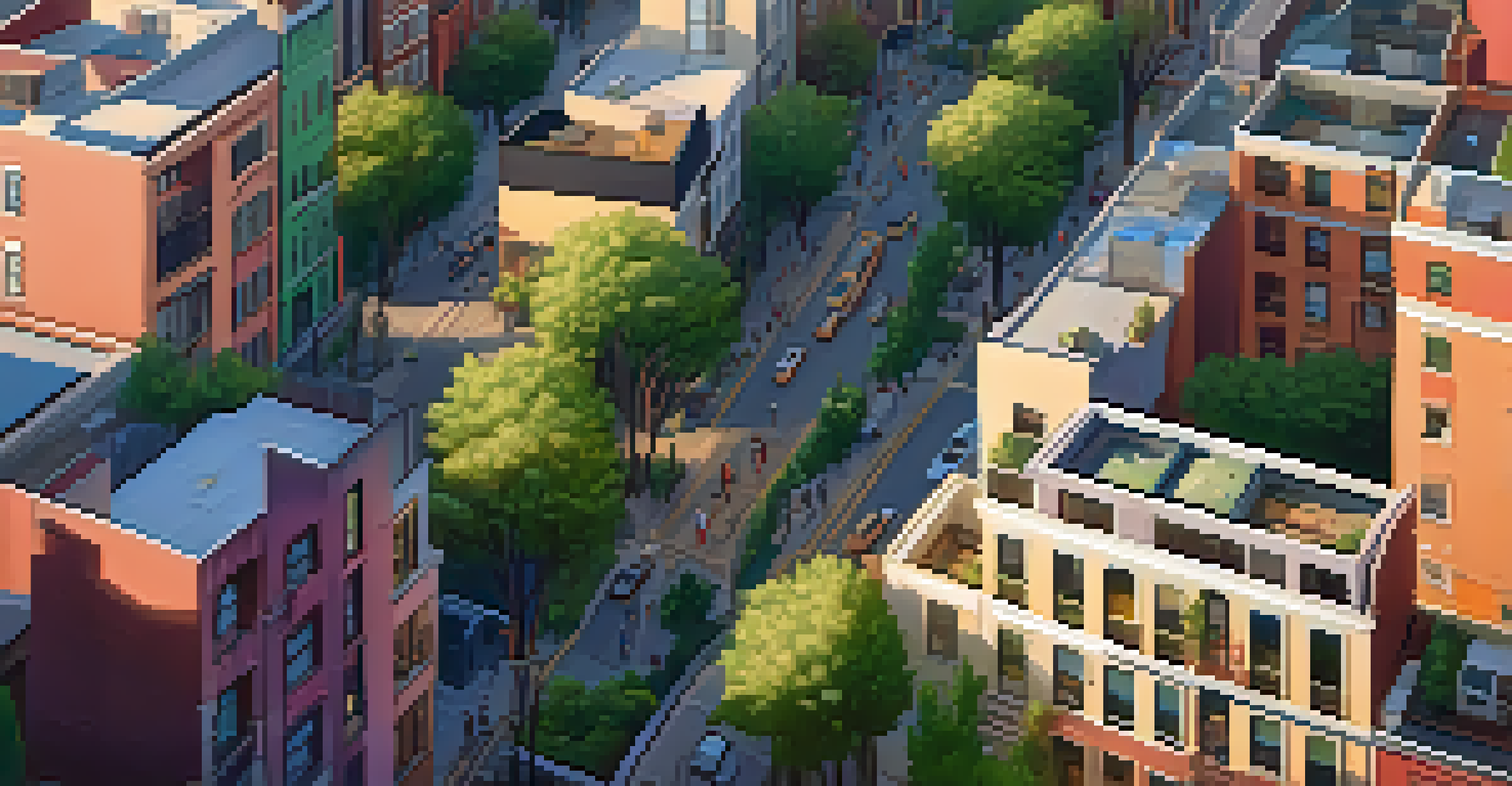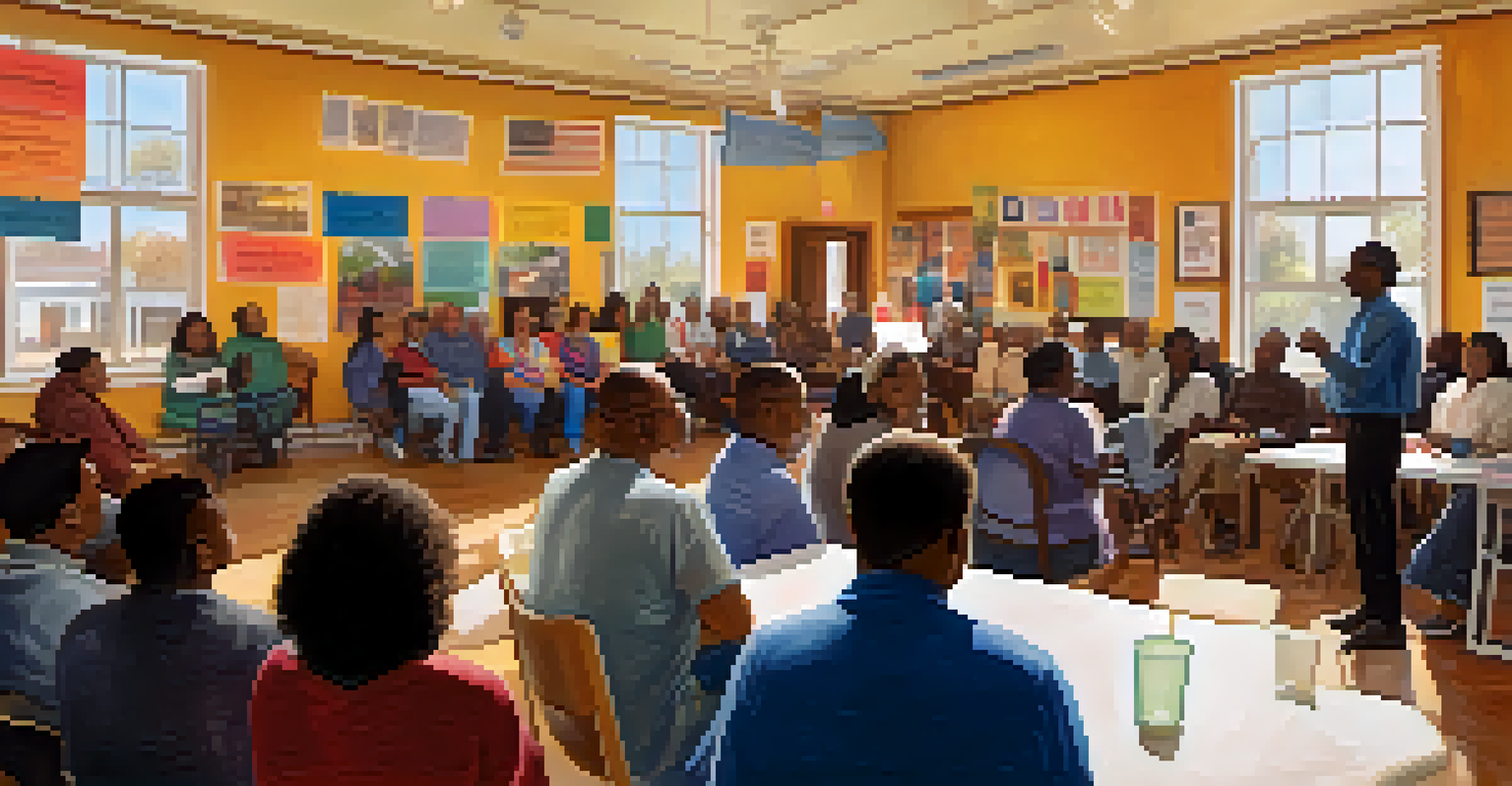Gentrification in Major Cities: Case Studies and Insights

Defining Gentrification: What It Means for Cities
Gentrification is a complex process that transforms urban neighborhoods. It often involves an influx of higher-income residents, which can lead to rising property values and rents. While this change can revitalize communities, it also raises concerns about displacement of long-time residents. Understanding gentrification requires a balanced view of its benefits and drawbacks.
Gentrification is a complex process that transforms urban neighborhoods.
For instance, a neighborhood may see new cafes and shops open as wealthier individuals move in. This can enhance local amenities and attract more businesses. However, the flip side is that existing residents may find themselves priced out of their own homes, leading to a loss of community identity.
In essence, gentrification is a double-edged sword. It can breathe new life into struggling areas but can also create significant social challenges. Recognizing this complexity is crucial when examining specific case studies in major cities.
Gentrification in New York City: A Closer Look
New York City serves as a prime example of gentrification's powerful effects. Neighborhoods like Harlem and Williamsburg have undergone significant transformations over the past few decades. Once considered less desirable, these areas now boast high-end restaurants, art galleries, and luxury apartments.

However, this transformation has not come without controversy. Long-time residents often face increased rents and a changing cultural landscape that can feel alienating. Activists and community leaders have voiced concerns about the loss of affordable housing and the unique character of these neighborhoods.
Gentrification: A Double-Edged Sword
While gentrification can revitalize neighborhoods and enhance local amenities, it often leads to the displacement of long-time residents and a loss of community identity.
Ultimately, New York's experience with gentrification illustrates the need for policies that protect vulnerable populations while fostering economic growth. Balancing development and community needs remains a significant challenge for city planners.
San Francisco: The Tech Boom and Gentrification
San Francisco’s gentrification story is closely linked to the tech boom. With major companies setting up shop in the city, an influx of tech workers has dramatically changed the local economy and housing market. Neighborhoods like the Mission District have seen surging rents that reflect this demand.
Effective policy is crucial in addressing the impacts of gentrification on communities.
As high-income earners move in, many long-time residents have been forced to relocate. The cultural fabric of these neighborhoods is at risk, as diverse communities are displaced. This has sparked protests and discussions about housing policies and the right to the city.
In response, San Francisco has implemented measures like rent control and affordable housing initiatives. However, the challenge remains to create a sustainable city that accommodates all its residents while encouraging economic growth.
Chicago: Balancing Revitalization and Displacement
In Chicago, gentrification has sparked a dialogue about revitalization versus displacement. Neighborhoods such as Pilsen and Logan Square have experienced a wave of new developments and rising property values. While these changes can bring improvements, they also threaten the existing community's stability.
Local residents often find it difficult to keep up with the rising costs of living. This has led to a loss of cultural heritage, as families who have lived in these areas for generations are forced out. The challenge lies in finding a way to promote growth without sacrificing the communities that have long called these neighborhoods home.
Need for Inclusive Policies
Cities facing gentrification must implement inclusive policies that protect vulnerable populations while promoting economic growth to ensure that all residents can benefit.
Chicago's experience highlights the importance of inclusive development strategies. Engaging community members in decision-making can help ensure that revitalization efforts benefit everyone, not just new arrivals.
Gentrification in Washington D.C.: A Political Landscape
Washington D.C. presents a unique case of gentrification intertwined with its political landscape. As the city has grown economically, areas like Shaw and Anacostia have seen significant investment and development. However, this growth often comes at a cost to existing residents who face displacement.
The city has implemented various policies aimed at addressing these issues, including inclusionary zoning and affordable housing programs. These initiatives aim to create a more equitable environment where long-term residents can benefit from the growth.
Despite these efforts, the challenges persist. Community advocates continue to push for stronger protections and sustainable development practices that honor the city’s rich history and diverse populations.
The Role of Policy in Mitigating Gentrification Effects
Effective policy is crucial in addressing the impacts of gentrification on communities. Many cities are recognizing the need for comprehensive approaches that balance development with the needs of existing residents. Policies such as rent control and affordable housing incentives can provide much-needed relief.
Additionally, community land trusts and cooperative housing models offer innovative solutions to prevent displacement. By allowing communities to have a stake in the land, they can maintain their neighborhoods even as property values rise.
Grassroots Movements Matter
Community-led initiatives are crucial in advocating for residents' rights and preserving the cultural identity of neighborhoods facing gentrification.
Ultimately, policymakers must consider the voices of residents when crafting solutions. Engaging the community in discussions about development can lead to more equitable outcomes that benefit everyone.
Community Responses to Gentrification: Grassroots Movements
Grassroots movements play a pivotal role in combating the negative effects of gentrification. Residents often band together to advocate for their rights and push back against displacement. These community-led initiatives can raise awareness and influence local policy decisions.
For example, organizations in gentrifying neighborhoods often work to preserve affordable housing and promote local businesses. By fostering a sense of community, they help maintain the cultural identity that makes these areas unique.

Through collective action, residents can have a significant impact on the development narrative. Their stories and experiences are essential in shaping a future that respects both growth and community heritage.
Looking Ahead: The Future of Gentrification in Major Cities
As urban areas continue to evolve, the conversation around gentrification will remain relevant. The balance between development and community preservation is delicate, requiring ongoing dialogue and innovative solutions. Major cities must learn from past experiences to create a more inclusive future.
With technology and remote work changing the landscape, new opportunities for equitable development are emerging. Cities can leverage these changes to foster environments where all residents thrive, regardless of income level.
Ultimately, the future of gentrification depends on how we address its complexities today. By prioritizing community engagement and sustainable practices, cities can work towards a more equitable urban landscape.